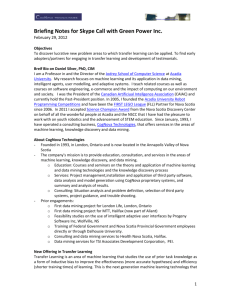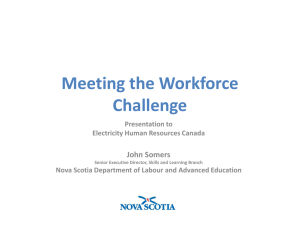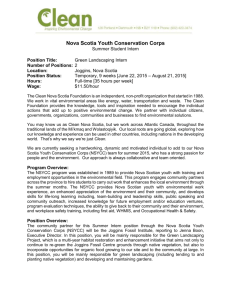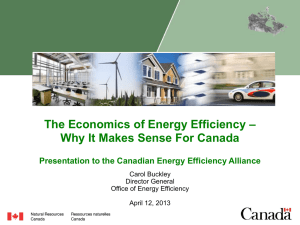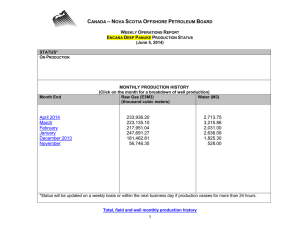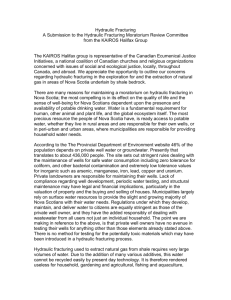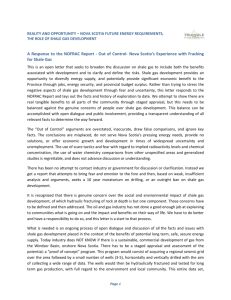Peter Hill
advertisement
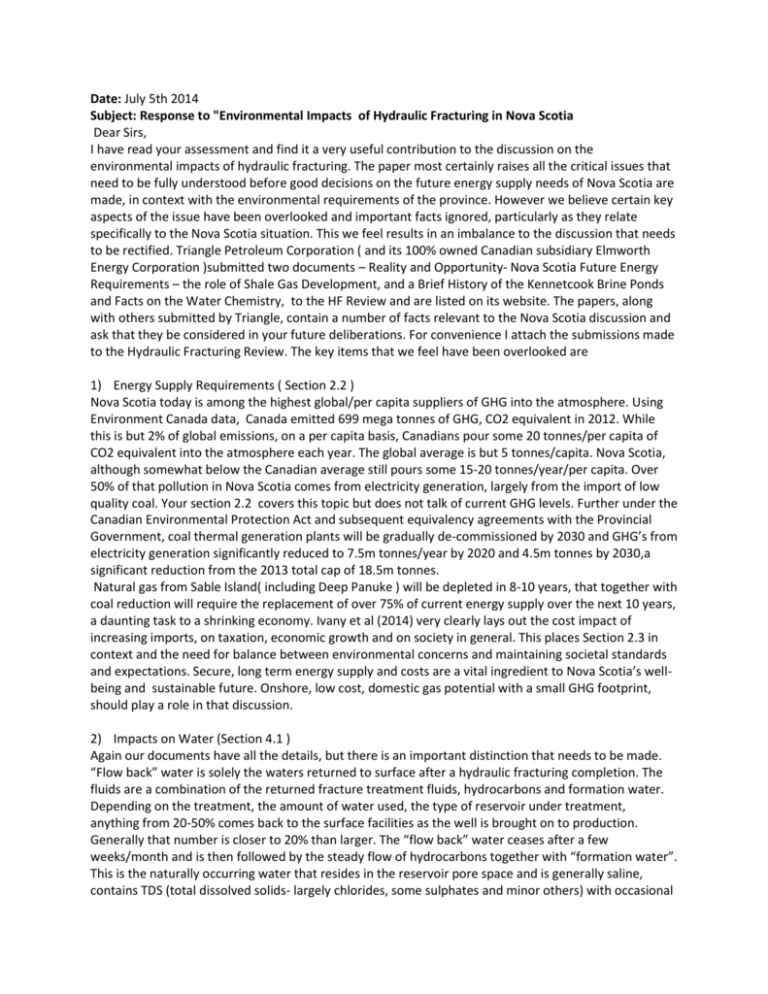
Date: July 5th 2014 Subject: Response to "Environmental Impacts of Hydraulic Fracturing in Nova Scotia Dear Sirs, I have read your assessment and find it a very useful contribution to the discussion on the environmental impacts of hydraulic fracturing. The paper most certainly raises all the critical issues that need to be fully understood before good decisions on the future energy supply needs of Nova Scotia are made, in context with the environmental requirements of the province. However we believe certain key aspects of the issue have been overlooked and important facts ignored, particularly as they relate specifically to the Nova Scotia situation. This we feel results in an imbalance to the discussion that needs to be rectified. Triangle Petroleum Corporation ( and its 100% owned Canadian subsidiary Elmworth Energy Corporation )submitted two documents – Reality and Opportunity- Nova Scotia Future Energy Requirements – the role of Shale Gas Development, and a Brief History of the Kennetcook Brine Ponds and Facts on the Water Chemistry, to the HF Review and are listed on its website. The papers, along with others submitted by Triangle, contain a number of facts relevant to the Nova Scotia discussion and ask that they be considered in your future deliberations. For convenience I attach the submissions made to the Hydraulic Fracturing Review. The key items that we feel have been overlooked are 1) Energy Supply Requirements ( Section 2.2 ) Nova Scotia today is among the highest global/per capita suppliers of GHG into the atmosphere. Using Environment Canada data, Canada emitted 699 mega tonnes of GHG, CO2 equivalent in 2012. While this is but 2% of global emissions, on a per capita basis, Canadians pour some 20 tonnes/per capita of CO2 equivalent into the atmosphere each year. The global average is but 5 tonnes/capita. Nova Scotia, although somewhat below the Canadian average still pours some 15-20 tonnes/year/per capita. Over 50% of that pollution in Nova Scotia comes from electricity generation, largely from the import of low quality coal. Your section 2.2 covers this topic but does not talk of current GHG levels. Further under the Canadian Environmental Protection Act and subsequent equivalency agreements with the Provincial Government, coal thermal generation plants will be gradually de-commissioned by 2030 and GHG’s from electricity generation significantly reduced to 7.5m tonnes/year by 2020 and 4.5m tonnes by 2030,a significant reduction from the 2013 total cap of 18.5m tonnes. Natural gas from Sable Island( including Deep Panuke ) will be depleted in 8-10 years, that together with coal reduction will require the replacement of over 75% of current energy supply over the next 10 years, a daunting task to a shrinking economy. Ivany et al (2014) very clearly lays out the cost impact of increasing imports, on taxation, economic growth and on society in general. This places Section 2.3 in context and the need for balance between environmental concerns and maintaining societal standards and expectations. Secure, long term energy supply and costs are a vital ingredient to Nova Scotia’s wellbeing and sustainable future. Onshore, low cost, domestic gas potential with a small GHG footprint, should play a role in that discussion. 2) Impacts on Water (Section 4.1 ) Again our documents have all the details, but there is an important distinction that needs to be made. “Flow back” water is solely the waters returned to surface after a hydraulic fracturing completion. The fluids are a combination of the returned fracture treatment fluids, hydrocarbons and formation water. Depending on the treatment, the amount of water used, the type of reservoir under treatment, anything from 20-50% comes back to the surface facilities as the well is brought on to production. Generally that number is closer to 20% than larger. The “flow back” water ceases after a few weeks/month and is then followed by the steady flow of hydrocarbons together with “formation water”. This is the naturally occurring water that resides in the reservoir pore space and is generally saline, contains TDS (total dissolved solids- largely chlorides, some sulphates and minor others) with occasional exotic minerals and sometimes NORM’s. “Formation water” remains throughout the life of the well and generally increases in percentage terms through well life, reaching up to 90% of the well bore flow in some instances. As part of the development of unconventional oil and gas accumulations the disposal of produced water is a key ingredient that has to be managed and the environmental impacts very carefully considered and answered over the life of the well ( 20 years or more ). In the specific case of Nova Scotia, Triangle has been careful to ensure we kept all parties informed of our actions and minimized the impact of the hydraulic fracturing program on the environment. Our papers lay out the total chemistry of the fracture treatment, the full analysis over time of the brine ponds at Kennetcook and the efforts we have made to see the ponds drained, and the sites fully remediated. As can be seen the Kennetcook tests, flow back and formation waters were very modest, and used benign chemicals throughout, with a total 5-6,000cu.m ( 5-6million liters ) of combined flow back and formation water in each pond. No hydrocarbons were recovered during the testing. The pond waters have grown significantly over the years through the addition of rain water, to the current 89,000cu.m and have further diluted the chemistry and stratified the ponds. Offtake over the years to various sites to prevent overspill was approved by all parties concerned. We were almost to the point of complete treatment and drainage to Debert in late 2011 when NORM measurements, emotions and politics crept into the issue with little regard for the facts as laid out. I agree, as you note in your review, it is testament to the “wicked “problem that industry and provincial government cannot find solutions to the speedy drainage of the ponds, and the future timing and direction of the evaluation of the shale gas potential of the Windsor Basin. We should not forget there has been no production of gas from the Windsor Basin and while there is a vast amount of potential gas locked up in the Horton Bluff Formation, enough energy to satisfy generations, nothing has been delivered to date. We feel a “proof of concept” program is needed to see if sustainable, commercial volumes of gas can be produced that meets the environmental requirements of all affected communities and Nova Scotia. That is the first priority and we are convinced that can be achieved with full consultation and planning with all parties. But we ask for consideration of the facts of the benign water chemistry, and the low level of NORM concentration, that only occurs in the deeper areas of the ponds in the TDS. All other NORM measurement is below Health Canada guidelines for Unconditional Derived Release Limits (UDRL) based on drinking water ingestion pathways. This is a very high standard when none of the pond waters will pass to direct human ingestion, but were the limiting measurement parameters chosen by the Department of Environment. NORM analysis identifies Radium 226, and as such means any tolerances should be based on potential ingestion as drinking water. Ingestion is required as Radium is an alpha emitter and the rays travel but short distances and are stopped by air, paper or skin. To exceed the general HC radio-activity absorbtion guidelines of 0.1mSv/a, a person would need to drink some 30,000 liters of the pond water over a lifetime, a near impossibility. We acknowledge the brines need careful treatment away from human food chain consumption but Triangle and it’s service contractors have offered on many occasions, very practical solutions that fully meet all scientific and Environment requirements, only to be ignored or dismissed with no reason. We acknowledge that Triangle ( Elmworth ) are fully responsible for the timely and effective drainage and remediation of the Kennetcook ponds and site, but we do need the approval and realistic understanding of the situation, with full and open discussion. Dialogue and co-operation with the government regulators have been missing for too many years to the detriment of the local communities and those seeking good and practical solution. Our latest submission was made in March 2014 and we have tests ongoing at the Lafarge cement kilns where treated waters are used as coolants. We have also sought Environment approval for discharge through the Debert Municipal Sewerage Treatment Facility of fully treated brines meeting all requirements of potable waters. In April, following best-practice in Canada and other places in the world, we proposed to re-inject fully treated brines back down the well bores at Kennetcook, that avoids the 1,200 truck movements that will be needed to remove the brines to other discharge sites. We await a response These points raised above are facts. Again Ivany et al (2014) touched on the need for a different approach and mindset of politicians, industry leaders and society to wrestle with these difficult issues. New solutions are required to face the realities of Nova Scotia in 2014. Energy supply is one of those key issues. The “wicked” problem persists, and I wish you well in your deliberations bringing the entire issue of hydraulic fracturing into focus and full, open, fact based discussion that is free of politics and emotion Thank you for your time and consideration Sincerely Dr. Peter J. Hill President, Elmworth Energy Corporation Chairman, Triangle Petroleum Corporation Peterhill47@gmail.com


